views
X
Research source
Making Quick Conversions

Write the number of ounces. Give this number the label "ounces." Let's follow along with an example problem. Let's say that we're converting a recipe from imperial to metric units for a European friend. If the recipe calls for eight ounces of chicken, we would write "8 ounces" on our paper.

Multiply by 28.35. This is the number of grams in one ounce. The answer you get will be the number of grams you're looking for. In our example problem, 8 ounces × 28.35 = 226.8 grams of chicken. Don't forget to label your answer "grams." If you're doing this for school, you may lose points if you forget the label.

For precise conversions, multiply by 28.349523125. The 28.35 number above isn't actually exactly how many grams are in one ounce. The actual number is much closer to this long decimal. If you need your answer to be very accurate, use this. Otherwise, 28.35 is fine. In our example above, if we wanted to be super-accurate about the amount of chicken in the recipe, we would multiply 8 × 28.349523125 = 226.796185 grams — a very small difference.
Converting Without a Calculator
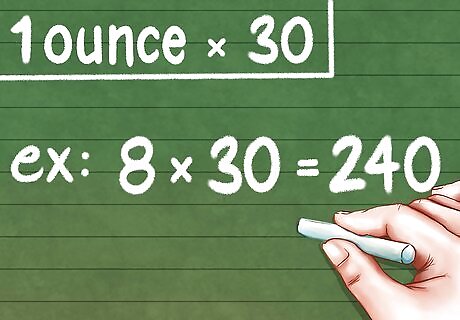
Multiply by 30. If you're stuck without a calculator, try this trick for converting ounces to grams in your head. Start by multiplying your ounces by 30. This is easy in your head — it's the same as multiplying by 3 and adding a 0. Let's use the method in this section to convert 8 ounces to grams again. 8 × 30 is the same as 8 × 3 (24), plus a 0 (240).
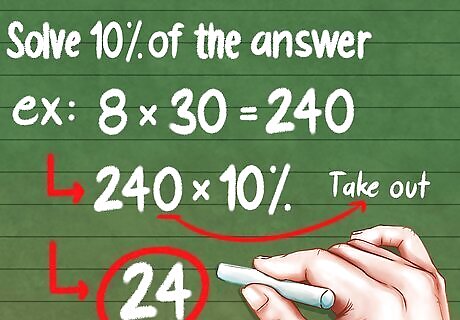
Figure out 10% of your answer. To do this, you can just take the zero off. In other words, it's the same as your original number times three. In our example, 10% of 240 is 24 (we just took the 0 off).
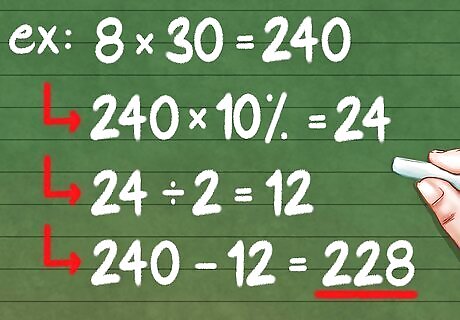
Subtract half of 10% from your original answer. With this strategy, you can get very close to the 28.35 conversion without even touching a calculator. Half of 24 is 12. 240 - 12 = 228 grams. This pretty close to our original answer (226.8 grams) — especially for not using a calculator.
Using a Conversion Ratio
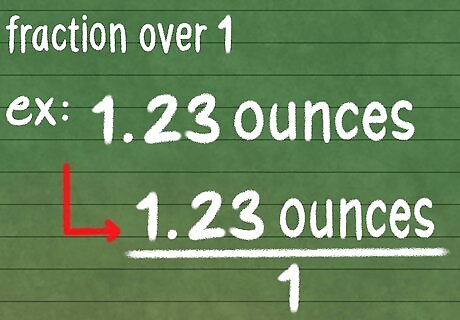
Write the value in ounces as a fraction over 1. This section uses fractions to show how the units in the problem relate to each other. Start by writing your number of ounces as the top part of a fraction (the numerator). Put "1" in the bottom part (the denominator) with no units. Let's say that we're doing a chemistry experiment and that, at the end of our reaction, we get 1.23 ounces of product. To start converting this to grams, we would write it like this: 1.23 ounces/1 Don't forget to label the ounces in the numerator. It's important for this kind of conversion.
Multiply by (1 gram/0.035 ounces). This is the conversion ratio for grams and ounces. Basically, it's a fraction that shows how many ounces are in a gram. Ignore the units for now as you multiply. See our article on multiplying fractions if you need help. In our example, we would multiply like this: 1.23 × 1 = 1.23 1 × 0.035 = 0.035 So our final fraction is 1.23/0.035

Cancel the units and divide. Notice that "ounces" appears twice: once in the first fraction's numerator and again in the second fraction's denominator. If you're multiplying fractions and a unit appears once in both the top and bottom, you can remove it from the problem. The units you're left with (grams) are the units for your answer. Now just divide to solve. In our example problem, we can cancel out the two "ounces" because they appear once on the top and once on bottom. This leaves us with grams. To get our answer, we just divide 1.23/0.035 = 35.14 grams.
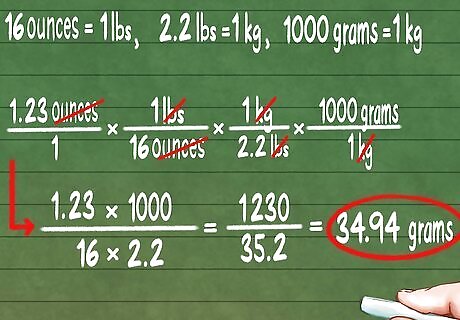
For multiple conversions, arrange your ratios so the proper units cancel. One of the nice things about using conversion ratios is that they make it easy to make lots of conversions in a row. All you need to do is use the same process as above, arranging multiple ratios so that all the units cancel except for the ones you want for your answer. See below: Let's say that we forgot how to convert from ounces to grams, but we do know that there are 16 ounces in a pound, 2.2 pounds in a kilogram, and 1,000 grams in a kilogram. This is enough to get us our answer. We would arrange our ratios like this: 1.23 ounces/1 × 1 pound/16 ounces × 1 kilogram/2.2 pounds × 1,000 grams/1 kilogram All the units cancel out except for grams, so these are the units for our answer. Now we just need to solve: = (1.23 × 1,000)/(16 × 2.2 ×) = 1,230/35.2 = 34.94 grams (almost the same as our original answer)
















Comments
0 comment